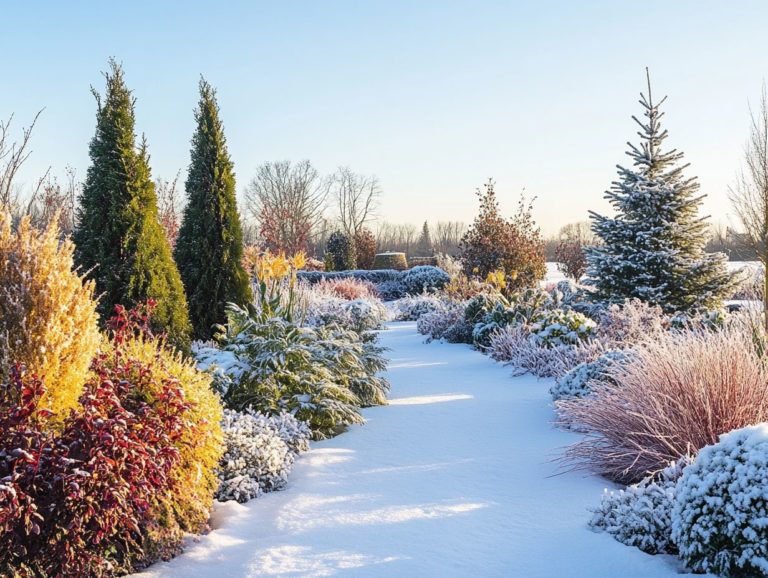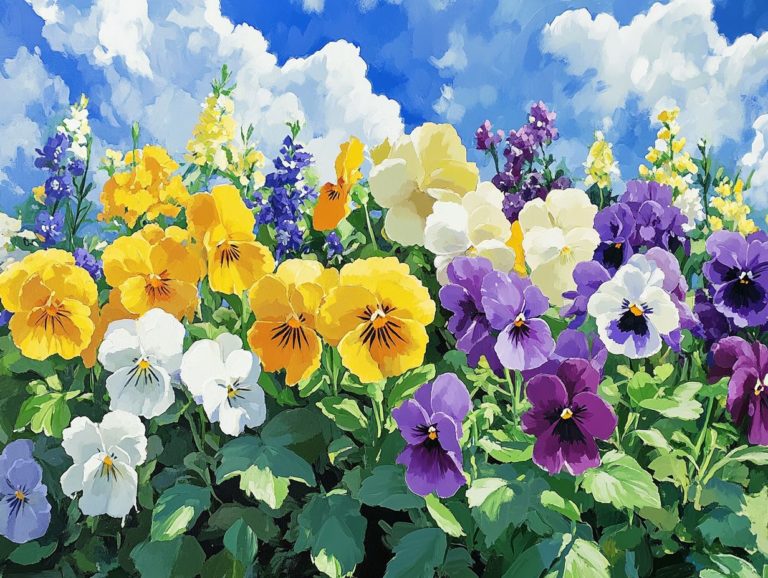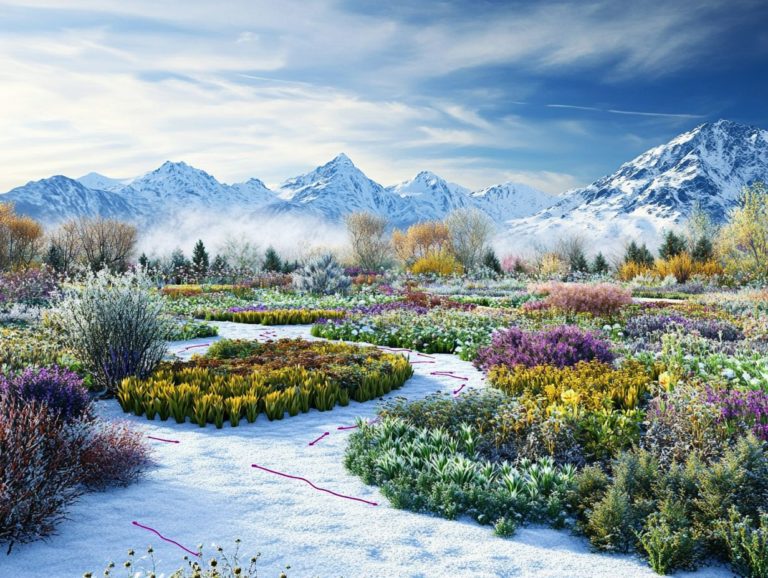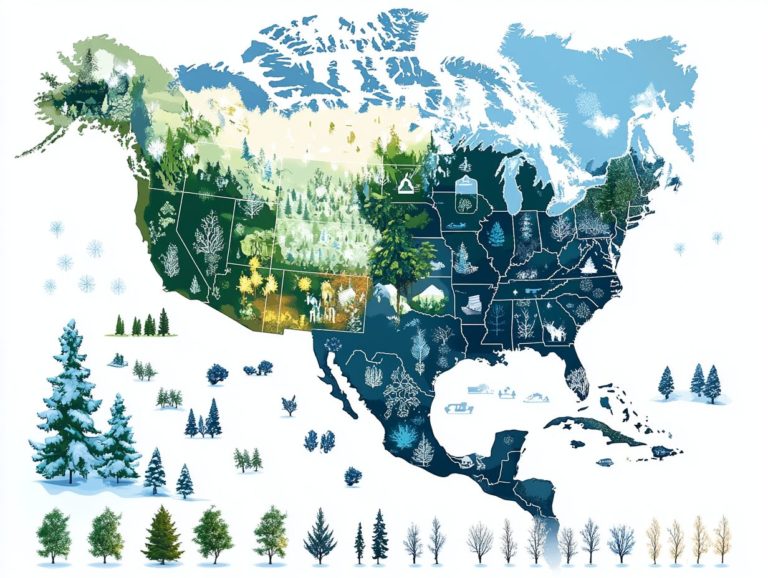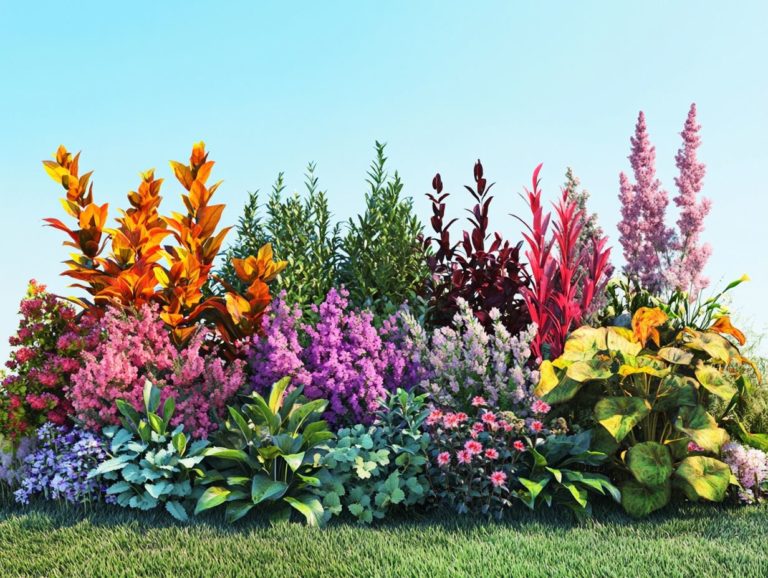Choosing Plants for Cold-Climate Containers
This guide helps you choose the best plants for cold conditions. It also covers how to prepare your containers for winter and maintain them for success.
Uncover essential tips on insulation, drainage, frost protection, and effective watering strategies to keep your plants flourishing, even in the cold. Ready to transform your gardening experience? Discover how to thrive even in the cold!
Contents
- Key Takeaways:
- Benefits and Challenges of Growing Plants in Cold Climates
- Choosing the Right Plants for Cold-Climate Containers
- Prepping and Maintaining Containers for Cold Weather
- Tips for Successful Cold-Climate Container Gardening
- Frequently Asked Questions
- What are some important factors to consider when choosing plants for cold-climate containers?
- How do I determine a plant’s hardiness zone?
- Which plants are best for cold-climate containers?
- Can I use annual plants in cold-climate containers?
- How can I protect my plants in cold-climate containers from harsh winter weather?
- Are there any low-maintenance plant options for cold-climate containers?
Key Takeaways:
- Consider factors like hardiness, sunlight, and container size when choosing plants.
- Insulate containers and protect plants from frost for survival.
- Master watering and fertilizing for thriving container gardens.
Benefits and Challenges of Growing Plants in Cold Climates
Growing plants in cold climates offers unique benefits and challenges. You can create vibrant arrangements with cold-hardy plants, but careful planning is essential.
By opting for evergreen shrubs like Juniperus and Buxus, you can elevate your winter displays, creating beautiful arrangements. However, it’s crucial to prioritize frost protection in this endeavor.
Choosing the Right Plants for Cold-Climate Containers
Selecting the ideal plants for cold-climate containers is crucial for achieving success in winter gardening. For more information, consider selecting the right containers for cold-climate plants, as this allows your arrangements to maintain their vibrancy against harsh conditions.
Consider incorporating cold-hardy plants like ornamental kale (Brassica oleracea) and cheerful flowering options such as Viola tricolor. For optimal growth, choosing the right soil for cold-climate plants will help infuse your containers with a splash of color.
Dwarf varieties, including mugo pine (Pinus mugo) and winter heather (Erica carnea), are exceptional choices for crafting stunning winter displays that not only endure but flourish in frigid temperatures.
Factors to Consider
Understand your hardiness zone. This detail will help you choose the best plants that can survive in your local conditions.
Take into account local climate variations, including temperature fluctuations, sunlight exposure, and seasonal precipitation. Prioritizing soil quality and drainage is vital to prevent root rot and promote robust growth.
When arranging your plants, consider the height and texture of each species. Place taller plants at the back and let trailing varieties cascade at the front for a stunning look.
Types of Plants that Thrive in Cold Climates
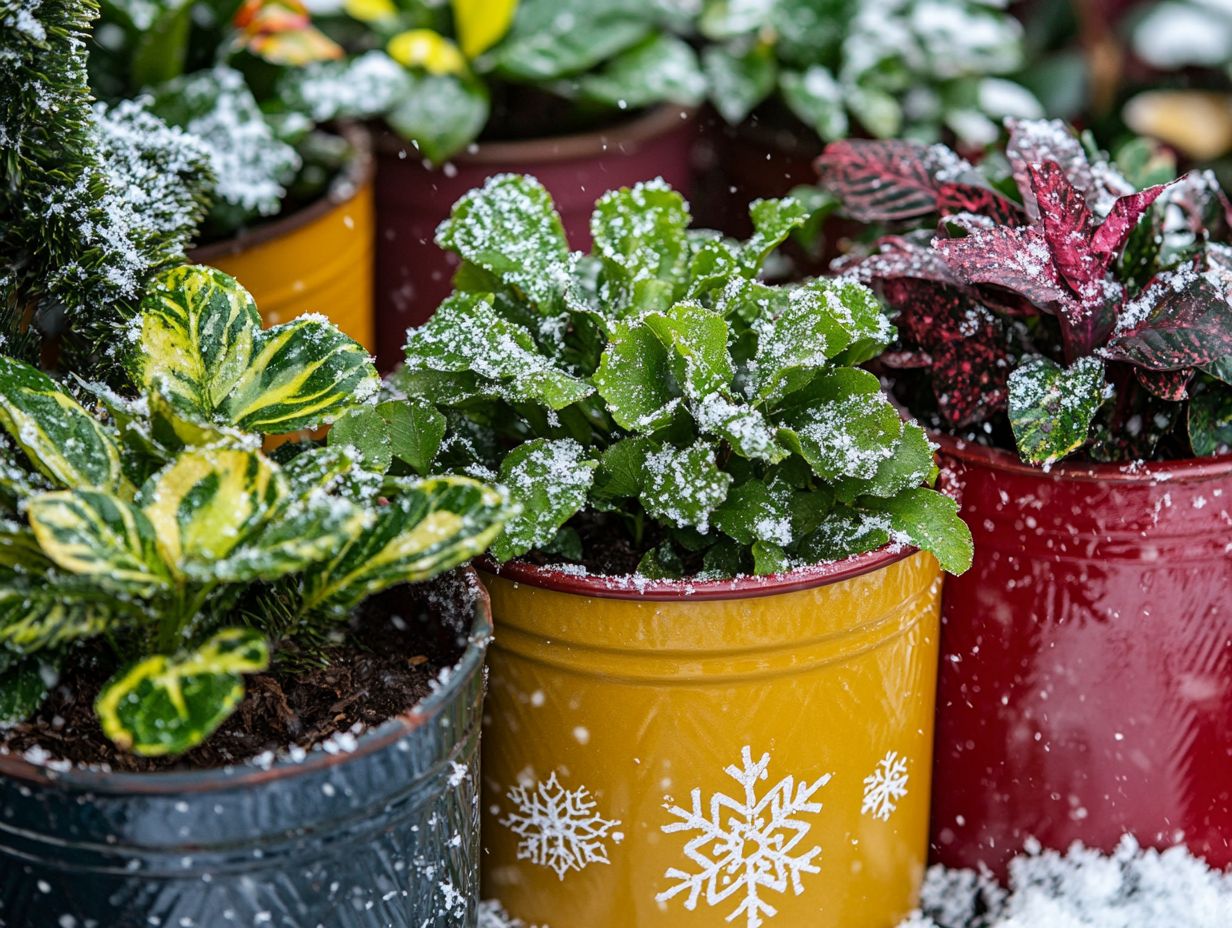
Many plants thrive in cold climates, and by selecting plants for shade in cold climates, you can create a stunning winter garden even as temperatures dip.
Cold-hardy plants, such as evergreen shrubs like Ilex crenata and Taxus baccata, along with resilient annuals, can endure the harshest winter conditions while adding visual interest to your landscape.
Incorporating native plants boosts your garden’s resilience. It also supports local wildlife.
Consider options like the vibrant Helleborus or the hardy Perovskia atriplicifolia. These plants add color and texture to your landscape during the colder months.
These cold-hardy varieties are also excellent in drought tolerance, meaning you’ll spend less time on upkeep during challenging weather.
Furthermore, native wildflowers attract beneficial pollinators and birds, enriching the ecosystem around you. Their adaptability ensures they thrive despite fluctuating temperatures, leading to a more vibrant and sustainable garden that not only pleases the eye but also contributes positively to the local environment.
Prepping and Maintaining Containers for Cold Weather
Preparing and maintaining your containers for cold weather is essential to ensure your plants thrive during the winter months. This requires employing specific strategies, including insulation and effective drainage techniques.
By utilizing proper insulation methods, you can shield the roots from freezing temperatures while keeping moisture levels just right. You can also use sturdy containers that withstand harsh weather.
Moreover, ensuring proper drainage will help you prevent root rot and other challenges associated with winter gardening.
Insulation and Drainage Techniques
Insulation and drainage are crucial for your container plants. Use mulch or bubble wrap for insulation, and make sure to prevent waterlogging.
By strategically placing materials like straw or leaves on top of the soil, you create an additional layer of insulation that traps heat and moisture while shielding the root system.
Incorporating drainage solutions such as elevated pots or drainage holes at the bottom enhances airflow and prevents stagnant water, which can be particularly detrimental during snow melts.
These methods work in harmony. The insulation retains warmth and moisture, while effective drainage allows excess water to flow away, creating an ideal environment. This balanced approach supports your plants vitality, helping them thrive through the chilly winter months.
Protecting Plants from Frost
Protecting your plants from frost is essential for maintaining the health and longevity of your winter garden, especially for hardy annuals and other cold-tolerant varieties. You can employ strategies such as covering containers with frost cloths or relocating them to sheltered spots. These actions can significantly reduce frost damage and foster healthier growth.
Familiarizing yourself with the timing of frost dates in your hardiness zone will enable you to prepare your plants effectively for the winter months. Stay alert to frost dates! Prepare your winter garden now for vibrant growth when spring arrives.
By keeping a close watch on local weather forecasts and monitoring temperature drops, you can take proactive steps to safeguard your plants. Utilizing barriers like burlap screens or blankets can offer additional insulation against the cold.
Grouping your plants creates a microclimate, a warm area that protects them from the cold. This not only provides extra warmth but also enhances their survivability.
Recognizing the specific needs of different plant varieties is crucial, allowing you to adjust your strategies accordingly. Always keep an eye on soil temperature; warmer soil can help mitigate the effects of frost, ensuring that your garden thrives even in the chill of winter.
Tips for Successful Cold-Climate Container Gardening

Successful cold-climate container gardening requires careful planning for watering and fertilizing. For those interested in enhancing their gardens, selecting cold-climate plants for urban gardens and effective overwintering techniques are key to ensuring your plants thrive in winter.
Understand your container plants’ water needs during colder months. With less evaporation, they may not need as much water as you think.
Adopting good fertilizing practices enhances plant resilience. This leads to vibrant growth, even in the depths of winter.
Watering and Fertilizing Strategies
Watering and fertilizing are essential for keeping your container plants healthy in winter. It’s about finding the right balance to ensure they get enough hydration without excess.
As temperatures fall, evaporation slows. Your plants may need less water, so monitor soil moisture closely to prevent root rot.
Using slow-release fertilizer is smart. It provides necessary nutrients without risking over-fertilization during the plants resting phase.
Learn watering techniques like deep watering. Let the top inch of soil dry out before the next watering to ensure your plants get just the right amount of moisture.
Don’t skip fertilization. Choose a balanced, low-nitrogen formula to support healthy growth without excessive leaf production.
Overwintering Techniques
Overwintering techniques help your plants endure harsh winter conditions. Insulating pots, providing shelter, or relocating containers can significantly boost their resilience.
Grouping containers creates a microclimate that offers extra protection. This simple act can make a big difference during winter.
Wrap pots in insulating materials like burlap or bubble wrap to protect roots from freezing. Moving containers to sheltered spots, like against a south-facing wall, maximizes sunlight while shielding from harsh winds.
When plants are close together, they share warmth and moisture, creating a cozy environment. This promotes healthier growth when spring arrives.
Frequently Asked Questions
What are some important factors to consider when choosing plants for cold-climate containers?
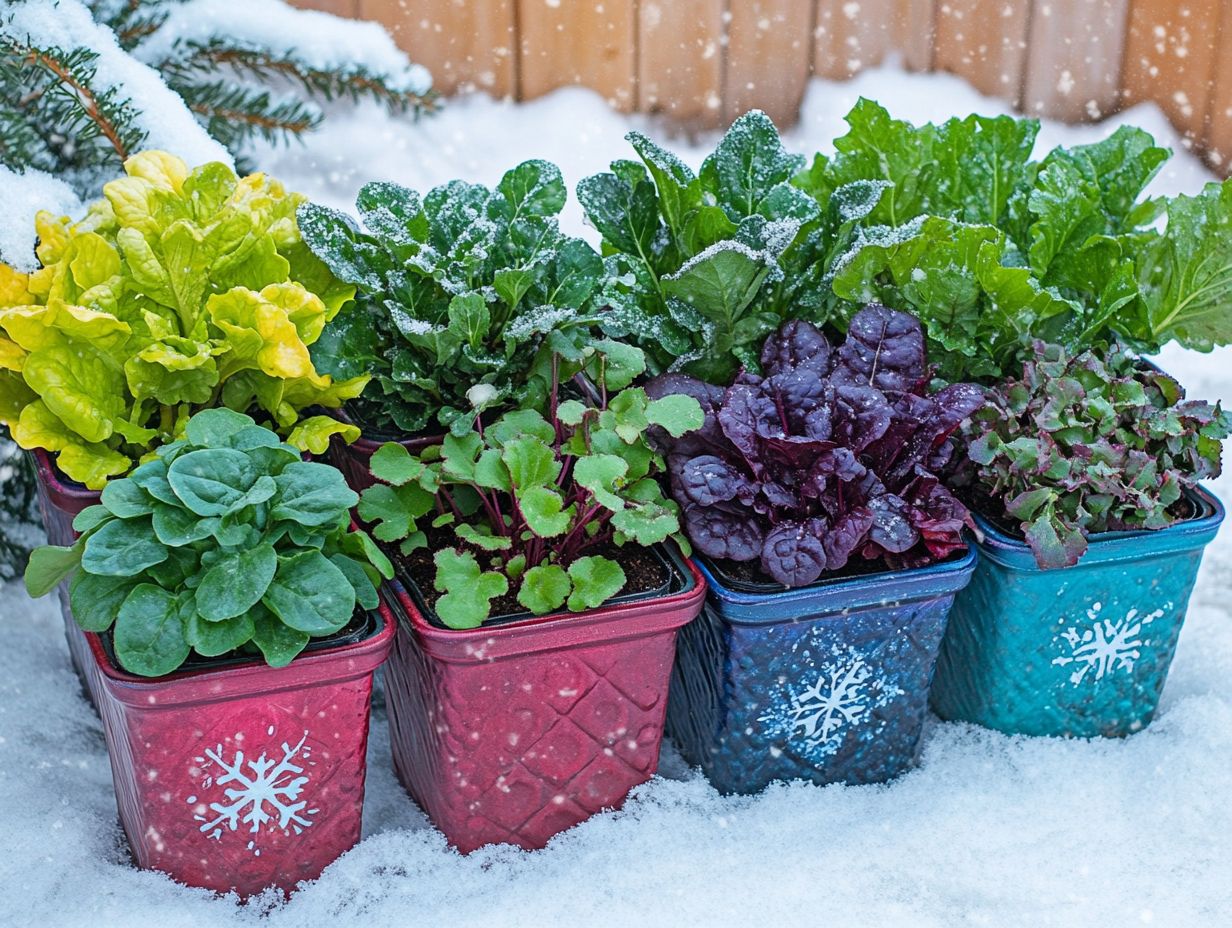
Consider the plant’s hardiness zone, its ability to withstand freezing temperatures, and its tolerance for winter winds.
How do I determine a plant’s hardiness zone?
Check the USDA Plant Hardiness Zone Map. It divides North America into 11 zones based on average minimum winter temperatures.
Which plants are best for cold-climate containers?
Great choices include evergreens, conifers, winter-blooming flowers, and cold-hardy vegetables like kale and Swiss chard.
Can I use annual plants in cold-climate containers?
You can use annual plants, but be sure to select plants for cold-climate rain gardens that are cold-hardy and can withstand freezing temperatures.
How can I protect my plants in cold-climate containers from harsh winter weather?
One way to protect your plants is by using containers with good insulation. Look for thick-walled containers or ones made from materials like stone or concrete, and consider exploring sustainable plant choices for cold climates to ensure your garden thrives.
You can also wrap the containers in bubble wrap or burlap for extra protection.
Are there any low-maintenance plant options for cold-climate containers?
Absolutely! Consider using small evergreen bushes, ornamental grasses, and succulents.
These tough plants thrive in winter and are super easy to care for!

